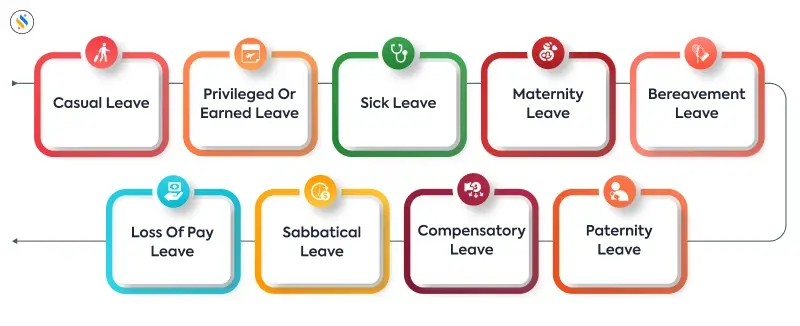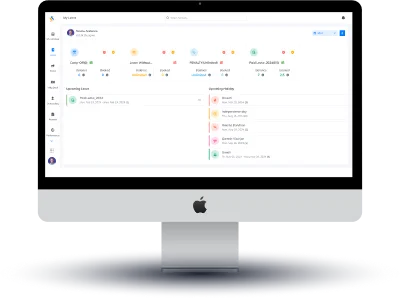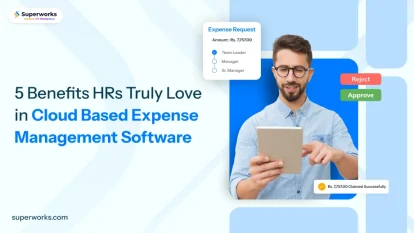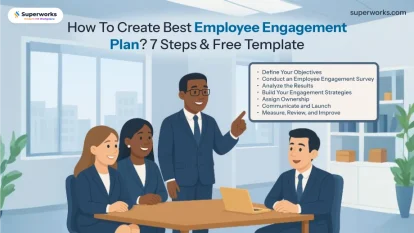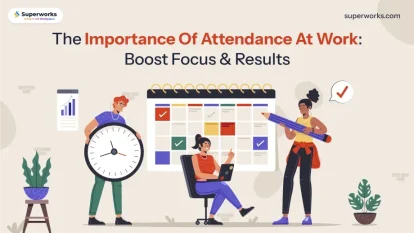Companies typically offer various types of leaves, including: Privileged leave, Casual leave, Sick leave, Bereavement leave, maternity leave, paternity leave, and many more. If you want to know more about the types of leaves you can check the Superworks website.
Grab a chance to avail 6 Months of Performance Module for FREE
Book a free demo session & learn more about it!
-
Will customized solution for your needs
-
Empowering users with user-friendly features
-
Driving success across diverse industries, everywhere.
Grab a chance to avail 6 Months of Performance Module for FREE
Book a free demo session & learn more about it!
Superworks
Modern HR Workplace
Your Partner in the entire Employee Life Cycle
From recruitment to retirement manage every stage of employee lifecycle with ease.


Seamless onboarding & offboarding
Automated compliance & payroll
Track performance & engagement
How To Manage Different Types Of Leave Easily With HRMS Software?
- types of leave
- 10 min read
- February 19, 2024
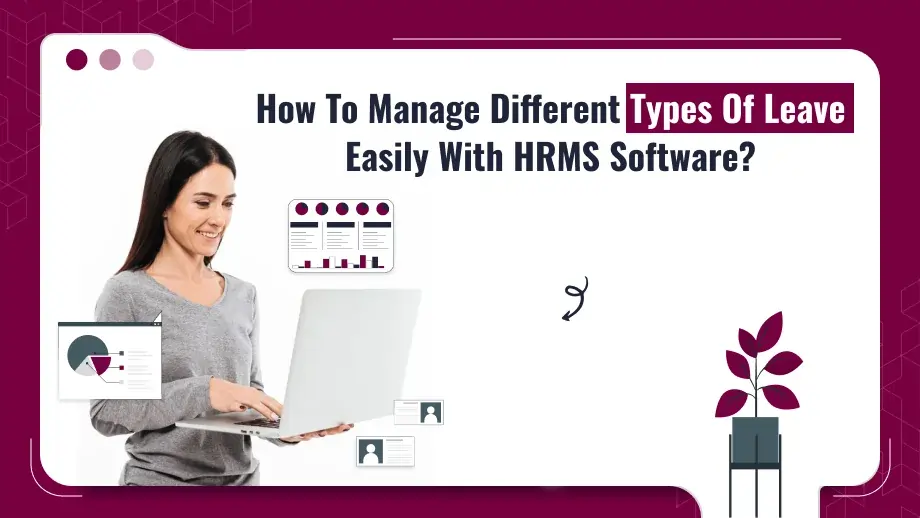
Leave! – Amazing word for every employee working in the office.
It’s a happy word for employees however a daunting task for HR managers to count it correctly.
Every company has its rules and there is a types of leave policy or rules in the company. Employees can take time off work, like paid leaves, vacation days, and public holidays. In this case, HR policy is important to control absences and maintain punctuality.
When someone is thinking about working for a company, they often ask about the company’s leave policy, leave encashment policy, and holidays in 2024 to schedule their whole year before joining it. Because having a good balance between work and personal life is important, and good leave policies help with that.
So, in this blog, we are talking about 9 different types of simple leaves that most employees are entitled to get in companies. HR Management department already defined the number of days that employees get for types of leave in a particular company.
If you’re an employer or HR manager, it’s important to follow the law when it comes to leave. We’ve made a list of different types of time off available to employees in India, so let’s get started and learn more about it!
To read more: A Guide: How Leave Management Software Shape the Future of HR
Most Common 9 Types Of Leave In Office
Here we mentioned some important and common types of leave in company that every employee and HR manager needs to know.
1. Casual Leave
Casual leave is like a break from work life for relaxation or for personal reasons.
Casual leave is one of the important types of leave- when an employee takes leave from work for things like vacations, traveling, relaxing, or attending family member events. Most companies offer these casual leaves so employees can take leave for important moments in their lives, such as going on vacation, a trip, or attending a wedding.
Giving employees paid casual leave shows that the company values their personal time and helps them feel appreciated. Usually, in most companies, employees can take around 8 to 15 days of casual leave in a year. Additionally, understanding privilege leave calculation is crucial for employees to effectively manage their overall leave entitlements.
Approval from a manager is usually needed to take casual leave. These types of leave also cover religious holidays such as Eid, Easter, and other minority festivals.
2. Privileged Or Earned Leave
Almost every company offers privilege leave or earned leave, it’s also called Paid leave (PL). These leaves are decided by the company and are mentioned in their leave policies. Employees just need their manager’s approval to take this leave.
Usually, it’s about 20-22 days per year, but it can vary depending on the company’s policy for different types of leaves and its HR rules. With paid leave, you can take time off work and still get paid for those days. That’s why it’s called Paid leave or earned leave.
3. Sick Leave
As the name suggests, sick leaves are taken when an employee is sick. Sometimes, they might also need to stay away from others to stop the illness from spreading.
Sick Leave is important because it lets employees take a break when they’re not well, without worrying about losing their pay. Many countries say companies have to give employees around 15 days of sick leave each year. But if someone is really sick, they might need more leaves as well.
Rules about sick leave are different in every country. Usually, companies have to give employees a certain amount of paid time off when they’re sick leave. In some countries, employees might feel uncomfortable asking for sick leave. But if a company makes employees feel bad about taking time off when they’re sick leave.
4. Maternity Leave
Maternity leave is crucial for new mothers, as they are going through the important process. Also, they have to bond with and care for their newborns. Companies that offer maternity leave help their employees feel less stressed during this time. Mothers get paid time off to recover from giving birth and look after their baby.
Women need time off to take care of their newborn babies and recover from pregnancy, usually around 3-4 months (14- 16 weeks).
Make sure your company’s policy includes this types of leave so employees don’t have to worry about work while they’re busy with their baby. It’s also important to be flexible and offer extra types of leave tracking if there are any complications after childbirth.
5. Bereavement Leave
Bereavement leave is not a much more common types of leave for employee, however, it can be considered casual leave sometimes. This leave is taken when an employee needs leave because someone they love has passed away. It’s a break from work so they can grieve, take care of funeral arrangements, and handle other tasks that come with losing someone.
Usually, companies give their employees mostly 1 day, however, some companies give several days as bereavement leave. one to several days of bereavement leave. This policy should give employees the time they need to mourn, deal with any tasks related to the death, and request bereavement leave without Pay any trouble.
6. Paternity Leave
A newborn baby needs a father as well, and that’s why paternity leave is given to new fathers—like husbands or partners of pregnant women, surrogate parents, or adoptive parents—so they can take care of their newborns without any worries.
Unlike maternity leave, new fathers usually get about 2 weeks off to look after their child after they’re born. Many companies don’t offer paternity leave because it’s not mandatory by law. In some countries, it’s required by law to give new fathers 1 to 2 weeks of paternity leave.
Also, See: HRMS Online System Vs Manual System: Prefer The Greater One!

Track different types of leave easily – Check Superworks – HRMS!
Manage workforce, manage leaves & manage payroll in one go, just explore the Superworks leave management system.
Make your HR save more time and work better with us.
7. Compensatory Leave
Compensatory leave makes managing time off easier for everyone involved. Compensatory leave is types of leaves in India, that companies use to handle overtime. If a company pays its employees for working extra hours, it might also offer compensatory Off leave. This types of leaves is also known as Comp Off Leave.
If you work more hours than usual, you can get paid for those extra hours later on. This helps keep track of leave and lets employees work flexibly.
8. Sabbatical Leave
Sabbatical leave means taking a break from work! It can help to focus on personal interests or to improve physical and mental health. Unlike shorter leaves, sabbaticals last for a long time such as a month, or months or a year.
Some companies give sabbatical leave application to employees who have been with them for more than 3 years.
9. Loss Of Pay Leave
If your employee has used up all their allowed leaves and wants more leaves for reasons other than special circumstances like maternity or bereavement, they can still take time off work. These kinds of leaves are known as unpaid leaves. This means their paycheck will be smaller for each day they’re not working.
If your company lets employees take as much leave as they need, you don’t need to set rules for unpaid leave. But you should keep an eye on things to make sure employees aren’t taking advantage of the policy.
Why Does Your Company Need A Perfect Leave Policy?
A well-structured leave policy is not just a bureaucratic necessity but a crucial component for fostering a healthy work environment. Let’s delve into why your company needs to have a perfect types of leave in place.
Legal Compliance
Leave policies in India must adhere to various labor laws such as the Factories Act 1948 and the Maternity Benefit Act. A robust leave salary exemption, which includes privilege leave calculation, ensures compliance with these regulations, shielding your company from legal repercussions.
Employee Well-being
Sick leave, casual leave, and bereavement leave are crucial for maintaining employee well-being. Providing adequate time off for personal reasons or emergencies fosters a supportive work environment and enhances employee morale.
Work-Life Balance:
Employees are entitled to a work-life balance. A comprehensive leave policy, which includes privilege leave calculation, allows them to manage personal commitments, take care of their health, and rejuvenate, ultimately improving productivity and job satisfaction.
Retention and Recruitment:
Competitive leave policies attract top talent and retain experienced employees. Prospective candidates often evaluate types of leave benefits, such as earned leave, when considering job offers. Offering generous joining report after availing earned leave entitlements, including earned leave, can give your company a competitive edge in recruitment.
Organizational Efficiency:
A structured leave policy ensures operational continuity by managing leave requests efficiently. Clear guidelines on requesting leave, approval procedures, and consequences of unauthorized absence streamline administrative processes.
Maternity and Paternity Benefits:
Maternity and paternity leave are fundamental rights protected by law. A well-defined leave policy outlines entitlements, duration, and eligibility criteria, demonstrating your company’s commitment to supporting employees during significant life events.
Compassionate and Bereavement Leave:
Employees may encounter personal tragedies requiring time off for grieving or attending last rites. Including compassionate leave in your policy demonstrates empathy towards employees during challenging times, fostering loyalty and trust.
Prevents Abuse:
A carefully structured leave policy discourages leave abuse by setting limits on accrued leave, specifying documentation requirements, and implementing fair procedures for monitoring absenteeism.
Flexibility and Adaptability:
While adhering to legal requirements, a perfect leave policy offers flexibility to accommodate diverse needs and preferences of employees. Options like unpaid leave, sabbaticals, or work-from-home arrangements enhance flexibility and promote employee satisfaction.
Company Culture:
Your leave policy reflects your company’s values and culture. A supportive and inclusive leave policy communicates your commitment to employee welfare, fostering a positive company culture and reinforcing employer-employee relationships.
Also, See: 10 Common Problems Of HR Onboarding Can Be Solved By HRMS Software
How To Manage These Leaves With Leave Management Software ( HRMS )?
Once you set up a leave policy for when employees can take different types of leave, it’s important to check how much time they’re taking off. This can be done with tracking software such as a leave management system or software.
-
A holiday calendar where an employee can see holidays and plan their year.
-
A leave calendar where you can plan when people will be away
-
Keeping track of when teams are off for holidays.
-
Different rules for different leave policy for employees, some might get more days off than others.
-
Make sure everyone’s records of how many leaves they’ve taken are correct.
-
A clear record of who said yes or no to a time off request, so nobody gets confused.
-
Keeping an eye on other kinds of work people might be doing while working from home.
-
Ways for employees to ask for leave using an app, which you can say yes or no to.
With a leave management for managing time off that’s based online, you can make a lot of the process happen automatically. This software mostly saves time and makes everything clearer. You can try our system for managing time off for free to see if it’s right for you.
Ready To Set Up A Leave Management System– HRMS For Your Company?
Keeping track types of leave is necessary and when each employee takes leave this can be counted for the payroll. But with, Superworks you can do it easily for you. human resource analytics can easily announce leave policy, employees can ask for leave using the employee self-service portal in HRMS software, and managers get messages to approve it. Once it’s approved, the leave is recorded automatically.
FAQs
What Are The Common Types of Leaves Provided By Companies?
How Does Leave Management Software Simplify The Process Of Taking Leaves?
Leave management software mostly streamlines the process by allowing employees to request time off digitally through Superworks. They can specify the type of leave, desired dates, and any necessary details. Managers can then review and approve requests promptly, reducing paperwork and administrative burdens.
Can Leave Management Software Accommodate Different Types Of Leave Policies?
Yes, leave management software can be configured to accommodate various leave policies tailored to the needs of different employees or departments. It can enforce rules such as maximum accrual limits, blackout periods, or differing entitlements based on tenure or position within the organization.
How Does Superworks Help In Tracking Employee Leave Balance?
Leave management software automatically tracks employee leave balances, updating in real-time as leave is accrued or taken. Employees can view their remaining leave balances at any time, reducing confusion and ensuring accurate records. Managers can also access this information to make informed decisions regarding staffing and scheduling.
What Are The Benefits Of Using Cloud-Based Software?
Cloud-based leave management software offers several advantages, including: Automation: Many tasks, such as leave requests, approvals, and balance calculations, are automated, saving time and reducing errors. Accessibility: Employees and managers can access the system from anywhere with an internet connection. Scalability: The software can accommodate the needs of growing organizations without requiring additional infrastructure. Data Security: Cloud-based solutions often have robust security measures in place to protect sensitive employee information. Integration: Integration with other HR systems or payroll software streamlines processes and enhances overall efficiency.
